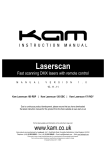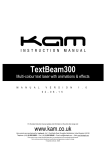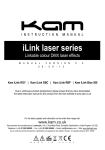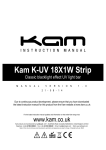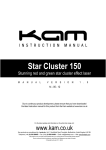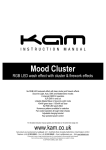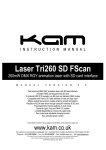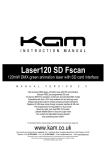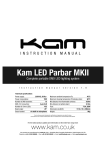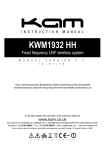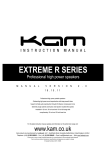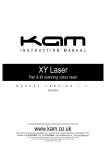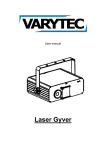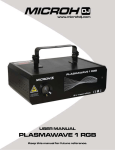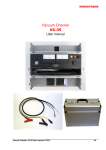Download Kam Laserscan 1000 3D V2 manual v1 16-04-14
Transcript
LASERSCAN 1000 3D V2 Exceptional 3D ILDA laser with 5 different effects in a single unit M A N U A L V E R S I O N 1 6 - 0 4 - 1 4 1 . 0 Due to continuous product development, please ensure that you have downloaded the latest instruction manual for this product from the Kam website at www.kam.co.uk For the latest instruction manual updates and information on the entire Kam range visit: www.kam.co.uk Kam products are manufactured by: Lamba plc, Unit 1, Southfields Road, Dunstable, Bedfordshire, United Kingdom LU6 3EJ Telephone: (+44) (0)1582 690600 • Fax: (+44) (0)1582 690400 • Email: [email protected] • Web: www.lambaplc.com If this product is ever no longer functional please take it to a recycling plant for environmentally friendly disposal. Due to continuous product development, specifications and appearance are subject to change. © Copyright Lamba plc 2014. E&OE. Thank you for purchasing this KAM product, we are sure that it will serve you for many years to come. To optimise the performance of this product, please read these operating instructions carefully to familiarise yourself with the basic operations of this unit. After you have read the instructions, please retain them for future reference. This unit has been tested at the factory before being shipped to you. To prevent or reduce the risk of electrical shock or fire, do not expose the unit to rain or moisture. To prevent a fire hazard, do not expose the unit to any naked flame sources. Unplug this apparatus during lightning storms or if it is unlikely to be used for long periods of time. When installing the unit, please ensure you leave enough space around the unit for ventilation. Slots and openings in the unit are provided for ventilation to ensure reliable operation of the product and to protect it from overheating. To prevent fire hazard, the openings should never be blocked or covered. Always handle the power cable by the plug. Never pull out the plug by pulling on the cable. Never touch the power cable when your hands are wet as this could cause an electric shock. Do not tie a knot in the cable. The power cable should be placed such that it is not likely to be stepped on. A damaged power cable can cause a fire or give you an electrical shock. Check the power cord periodicaly, if you ever find that it is damaged, replace it before using the unit again. Contact your retailer for a replacement. The voltage of the available power supply differs according to country or region. Be sure that the power supply voltage of the area where this unit is to be used meets the required written on the unit. The lightning flash symbol inside a triangle is intended to alert the user to the presence high voltage within the unit’s enclosure that may be of sufficient power to constitute a risk of electrical shock to persons. Caution: to prevent the risk of electric shock, do not attempt to open the unit. No user-serviceable parts inside. Refer all servicing to qualified service personnel. The exclamation mark inside a triangle is intended to alert the user to the presence of important operating and maintenance instructions in the literature accompanying the appliance. Any modification carried out on the unit may invalidate the unit’s warranty. If applicable, only use the stand, tripod or bracket specified or sold with the apparatus. Select the installation location of your unit carefully. Avoid placing it in direct sunlight or locations subject to vibration and excessive dust. Do not use the unit where there are extremes in temperature (below 41ºF / 5ºC or exceeding 95ºF / 35ºC). Unpacking and safety: Please unpack your new product carefully, your new product should reach you in perfect condition. Please check that no damage has occurred during transit. If any damage is found, do not operate your unit. Please contact the retailer you purchased it from immediately. If there is any damage to the mains cable do not use the device. Always disconnect the unit from the mains supply when carrying out any servicing or cleaning of the unit. The serial number for this equipment should be located on the rear or underside of the unit. Please make a note of this number as you will need it for your warranty, it is a good idea to keep a copy of the serial number for your own records. Unpacking instructions CAUTION! Immediately upon receiving a fixture, carefully unpack the carton, check the contents to ensure that all parts are present and have been received in good condition. Notify the shipper immediately and retain packing material for inspection if any parts appear damage from shipping or the package itself shows signs of mishandling. Save the package and all packing materials. In the event that a fixture must be returned to the factory, it is important that the fixture be returned in the original factory box and packing. Contents 1 x laser, 2 x keys, 1 x interlock connector and 1 x power cord. Power Supply Cable (EU) Brown Light Blue Cable (US) Black White Pin Live Neutral Yellow/Green Green Earth International L N DMX-512 connection between fixtures The fixture is equipped with 3-pin XLR sockets for DMX input and output. The sockets are wired in parallel. Only use a shielded twisted-pair cable designed for 3-pin XLR-plugs and connectors in order to connect the controller with the fixture or one fixture with another. XLR-connection Building a serial DMX-chain • • • • • If you are using a standard DMX-controller, you can connect the DMX-output of the controller directly with the DMX-input of the first fixture in the DMX-chain. If you wish to connect DMX-controllers with other XLR-outputs, you need to use adapter cables. (DMX controller not supplied). Connect the DMX-output of the first fixture in the DMX-chain with the DMX-input of the next fixture. Always connect output with the input of the next fixture until all fixtures are connected. If you use a controller with 5 pins DMX connector, you need to use a 5 to 3 pins adapter. The DMX output and input connectors are pass-through to maintain the DMX circuit, when power is disconnected to the unit. Each fixture needs to have a DMX address to receive the data from the controller. The DMX address number which could be read from rear panel of each fixture is between 000~511. Proper laser set up & usage This fixture has been designed to be hung. It is recommended for safety purposes, your lighting effect are properly mounted using a suitable hanging clamp and safety cable. Items appropriate for safe and effective mounting are easily sourced from your lighting vendor. International laser safety regulations require that lasers must be operated in the fashion illustrated below, with a minimum of 3 meters (9.8 ft) of vertical separation between the floor and the lowest laser light vertically. Additionally, 2.5 meters of horizontal separation is required between laser light and audience or other public spaces. 2 3 Front Panel 1. Laser output – Laser output aperture 2. Power – Red LED is ON 3. Music – Synchronise to detected music signal 1 Rear Panel 11 13 9 12 6 10 8 4. 5. 6. 7. 8. 9. Switch – Power on and off Mains input with intergrated fuse holder DMX input - 3 PIN Male XLR DMX output – 3 PIN Female XLR ILDA input – Standard ILDA DB25 input ILDA through – Standard ILDA DB25 output 14 7 10. 11. 12. 13. 14. 4 5 Cooling fan – Never cover the fan Safety eye – Attach the safety cable LED function displaY Safety switch – turns unit off immediately Key switch Operating Mode When the laser is powered on, the LCD monitor on rear panel shows the current operating standalone mode, DMX address or Slave mode. With help of the LCD control panel, it is very easy to set and change the operating mode of the laser. The next time the laser is powered on it will show the last setting used before the laser was powered off. Mode Option, to choose the operating mode of laser. Confirmation, to confirm the selected mode. UP/DOWN, to change operating mode, parameter or DMX address. Operation Display AuT A3d AuB AuL AuN Auo S3d Sob SoL SoN Soo Stand alone mode pre-programmed effect Automatically cycle through its built in programs. This mode will only show the “in air” effects. Automatically cycle through the built-in 3D effects Automatically cycle through the built-in traditional beam effects. Automatically cycle through the built-in northern lights effects. Automatically cycle through the built-in gratings effects. Automatically cycle through the built-in 3D universe effects. Cycle through the built-in 3D effects by sound activation Cycle through the built-in traditional beam effects by sound activation Cycle through the built-in northern lights effects by sound activation Cycle through the built-in gratings effects by sound activation Cycle through the built-in 3D universe effects by sound activation SOUND ACTIVATION MODE Sound sensitivity The laser has a built in microphone and to reduce and increase the sensitivity of the pick up, which will alter the reaction of the programs, use the Sound activation mode settings. • • • Press FUNC till you see S6 Press UP/DOWN to set the microphone sensitivity. S 0 is no sound activation, from S 1 to S 9; the sensitivity level will increase and be more sensitive. Press Enter to confirm. ATTENTION! In pre-programmed standalone MUSIC SHOW mode, the laser beam will black-out in 3 seconds without AUDIO/MIC activated signal. DMX MODE • Press FUNC to enter the MODE selection • The LED panel will show 001 for DMX mode • Press ENTER to confirm the setting Now the laser is working in DMX mode. Use the up/down buttons to select the DMX address. Note: In DMX MODE, once the DMX cable is connected to the laser and DMX controller, the DMX LED in front panel of laser will be ON. Controlling units via DMX - each unit uses 19 DMX channels To set the DMX address 1. Press the function button until *** is displayed (range 001-512) 2. Using the up / down buttons select the desired DMX starting address 3. Press the enter button to confirm 4. Continue this formula to address any additional units Note on setting the DMX address of units - If one or several units are to be controlled at the same time with the same features, set all units DMX address to the same value Example all units to 001 If individual control of several units is required, each unit must have its on unique address and no channels must cross Example unit 1 set to 001 – unit 2 to 020 etc adding 19 clear channels each time Master slaving units with no DMX controller Set the master unit to the desired setting Example: auto or sound Set all other units to slave mode To set slave mode press the function button until SLA is displayed then press the enter button to confirm Only one unit must be set as a master and all other units must be set as slave Connect each unit together via a 3pin DMX lead PATTERN MIRROR REVERSE SETTING • Press FUNC to enter the MODE selection • Use the up/down buttons to set the LED display to match Fig A. • Press ENTER to confirm the setting. FIG. A FIG. B • Using the up/down buttons, set the LED display to match Fig. B. This will rotate the graphic in the X direction. FIG. C • Using the up/down buttons, set the LED display to match Fig. C. This will flip the graphic in the Y direction. ILDA Control Mode This unit has the ILDA DB25 port which allows control of the laser via a PC/Mac laser or lighting software. The PC must be connected to an interface and then the ILDA cable from the interface is connected to the ILDA input socket on the rear of the laser. When connecting the ILDA plug to the laser this will override all built in standalone functions of the laser, and can then only be controlled by the PC/Mac software. Removing the ILDA cable will re-enable all standalone functions. Please note: it should be possible for any ILDA controlled software to operate this laser, if your software is having problems controlling the laser this maybe down to a cable connection issue. Some interfaces and cables may have different wiring configuration. The fourth and seventeenth pin of the ILDA socket need to be connected. If you rectify this issue on your interface then this will cure the control issue. DMX Channels Chart Several operating modes were pre-programmed into this laser projector on DMX channel 1. To enable full DMX control, channel 1 must be set to DMX control mode and have a value of 250-255 this will enable the rest of the DMX channels. DMX channels chart when ILDA is connected Channel Value 000-004 005-127 CH 1 – Grating rotation 128-133 134-255 000-031 032-063 064-095 096-127 CH2 – Grating effect 128-159 160-191 192-223 224-255 Function No grating rotating Clockwise grating rotating No grating rotating Anticlockwise grating rotating Laser 3D Effect Scanned Beam Effect (Pattern Effect) Laser Lumina Effect Scanned Beam Effect (Pattern Effect) Burst Grating Effect Scanned Beam Effect (Pattern Effect) Laser Universal Effect Scanned Beam Effect (Pattern Effect) DMX channels chart when ILDA is NOT connected Channel Value Function 000-018 Laser OFF 019-036 AUT Auto Show with Mixed 5 effect 037-054 A3D Laser 3D Effect Auto Show 055-072 AUB Scanned Beam Effect Auto Show 073-090 AUL Laser Lumina Effect Auto Show 091-108 AUN Burst Grating Effect Auto Show 109-126 AUO Laser Universal Effect Auto Show CH 1 – Mode 127-144 SOU Sound Show with Mixed 5 Effect 145-162 S3D Sound show with LASER 3D 163-180 SOB Sound show with Scanned Beam 181-198 SOL Sound show with LASER LUMIA 199-216 SON Sound show with Burst Grating 217-234 SOO Sound show with Laser Universal 235-255 DMX MODE 000-051 1 Group Patterns. 052-103 2 Group Patterns. CH 2 - Group 104-155 3 Group Patterns. 156-207 4 Group Patterns. 208-255 5 Group Patterns. CH 3 - Pattern 000-255 Every 16 for 1 Group, total 16 patterns. 000-007 Original 008-015 Red 016-023 Green 024-031 Yellow 032-039 Blue 040-047 Purple CH 4 - Colour 048-055 Light Blue 056-063 White 064-111 Colour Rolling 112-159 Colour Jumping 160-127 Colour Moving 208-255 Strobing 000 Full pattern without clipping CH 5 - Clipping 001-127 0%~99% fixed pattern clipped 128-255 Clipping Speed 000-127 100%-5% fixed pattern zoomed 128-169 Zooming IN CH 6 - Zooming 170-209 Zooming OUT 210-255 Alternately Zooming CH 7 – Zoom speed 000-255 Fast to Slow 000-127 0 -359 degree fixed Y axis rolled CH 8 – Y Axis rolling 128-191 Clockwise rolling 192-255 Anticlockwise rolling CH 9 – Roll speed 0-255 Fast to Slow 000-127 0 -359 degree fixed X axis rolled CH 10 – X Axis rolling 128-191 Clockwise rolling 192-255 Anticlockwise rolling CH 11 – Roll speed 0-255 Fast to Slow 000-127 0 -359 degree fixed Z axis rolled CH 12 – Z Axis Rolling 128-191 Clockwise rolling 192-255 Anticlockwise rolling CH 13 – Roll speed 0-255 Fast to Slow 000-127 128 different fixed position on X axis CH 14 – Y Axis moving 128-191 Clockwise moving 192-255 Anticlockwise moving CH 15 – Move speed 0-255 Fast to Slow 000-127 128-191 192-255 0-255 000-004 005-127 128-133 134-255 000-031 032-063 064-095 096-127 128-159 160-191 192-223 224-255 CH 16 – X Axis moving CH 17 – Move speed CH 18 – Grating rotation CH 19 – Grating effect Pattern list DMX 000-015 016-031 032-047 048-063 064-079 080-095 096-111 112-127 128-143 144-159 160-175 1 2 128 different fixed position on Y axis Clockwise moving Anticlockwise moving Fast to Slow No grating rotating Clockwise grating rotating No grating rotating Anticlockwise grating rotating Laser 3D Effect Scanned Beam Effect (Pattern Effect) Laser Lumina Effect Scanned Beam Effect (Pattern Effect) Burst Grating Effect Scanned Beam Effect (Pattern Effect) Laser Universal Effect Scanned Beam Effect (Pattern Effect) 3 4 5 176-191 192-207 208-223 224-239 240-255 The Kam LaserScan 1000 3D laser projector offers 5 different effects in one package. The unit has been classified as a Class 4 laser product (please refer to the KAM Class 4 Laser Product Guide for details of what this means) because it is capable of emitting high power laser beams that can cause eye damage. However, each of the 5 effects has a different hazard associated with it. It is the purpose of this guide to outline what these hazards are. The table below outlines all the effects and usage mode with an indication of the hazard potential for each. EFFECT MENU POTENTIAL HYPER 3D EFFECT NO DESCRIPTION HAZARD 1 3D PROJECTION 3B 2 NORTHERN LIGHTS 3R AUTO 3 MULTI GRATINGS 3B 4 KALEIDOSCOPE 3B 5 FLAT BEAM & IN AIR TUNNEL 4 1 3D PROJECTION 3B 2 NORTHERN LIGHTS 3R SOUND TO 3 MULTI GRATINGS 3B LIGHT 4 KALEIDOSCOPE 3B 5 FLAT BEAM & IN AIR TUNNEL 4 MODE SAFE DISTANCE OF USAGE 15m 0.5m 25m 140m 270m 15m 0.5m 25m 140m 270m MODE: This is either AUTO where each selected effect varies randomly or SOUND TO LIGHT where the selected effect changes in time to the beat of the music. EFFECT NO: This is the allocated number for the specific effect. 3D EFFECT: This is the name of the specific effect. MENU DESCRIPTION: This is the symbol that appears on the LED display on the back of the unit. POTENTIAL HAZARD: This the hazard presented by the effect. It is based on the product classification system and uses the following classes: 3R - can be considered safe. 3B - is hazardous and must be used with caution. 4 - is extremely hazardous and must be used with the utmost of caution. Note: A single beam can cause tissue burns a distances up to several metres! SAFE DISTANCE OF USAGE: This is the distance below which the effect can become hazardous when shone directly into the audience eyes. Use this effect beyond the distance shown. These figures have been arrived at by measuring the smallest beam shape that the unit can project for each effect – these represent its most concentrated beam power and thus its greatest hazard. These figures are to be used as a guide to help determine what kind of show one can carry out. Effects like the Wide Angle Starcluster (effect 7) can be safely directed into an audience and can look very spectacular. The Northern Lights (effect 3), even though it is safe, is more effective when projected onto a wall. Please also note that the settings Aut and Sou (Automatic Random and Sound to Light) must never be used for audience scanning as you have no control over which effect will be used! If unsure about a show, always project at least 3m above audience head height. This is particularly true for the effects 1 and 8 as the 3m rule applies to the lowest part of the scanned image that can fall onto an audience. For the effects 2, 4, 5 and 6 the 3m rule applies for the central part of the projection – the very edges of the display are reduced in power and can fall onto audience. Scan an audience, at the edges, with these effects at your discretion. When using this unit in DMX mode it is important to understand that this will override all internal effects and all the moving effects can be stopped to produce single beams. For this reason it is vital to ensure that no beams can go into audience at distances less than those specified in the table above. The same applies for the unit being used in ILDA mode – all the internally programmed images are overridden. Any audience scanning must be with the fastest possible scan rate and largest possible images at distances determined by careful calculation. If in any doubt – don’t audience scan. Please refer to the Kam Class 4 Laser Product Guide for more detailed information. Specifications Mains Input Fuse Total Power X/Y Axis Beam Angle Music Control Laser Power Laser Classification Laser Safety Standard Condition Temperature DMX Connections DMX Channels Measurements Nett Weight AC100~240V, 50/60Hz 250V /1.6A Slow Blow (20mm Glass) 48w ±20° Audio / Sound Activated 150mW 638nm red laser 100mW 532nm green laser 500mW 450nm blue laser Class 4 EN60825-1 2007 10~40° 3 pins XLR male/female Max 19 channels 290 x 190 x 245mm 4.2Kg













